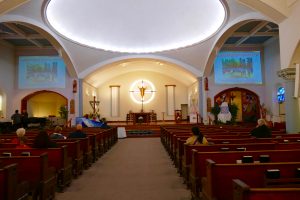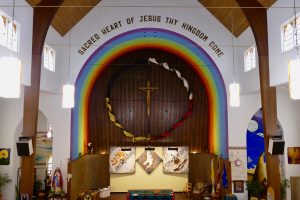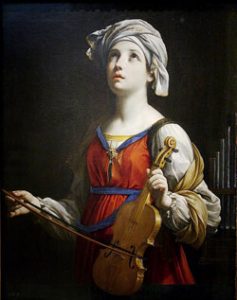Faith, Hope and Love: Memorial – St Cecilia
(2 Macc 7:1-31; Ps 17; Lk 19:11-28)
*****************************************
Some years ago, the St. Albert parish celebrated their 150th anniversary with a year-long series of speakers and events. I was invited to conduct a parish mission as part of that series, and was impressed by their theme: Rooted in Faith, Living in Hope and Growing in Love, expressed on three huge banners in the church.

St Albert Parish sanctuary
Those themes coincide with the message emerging from the readings today: pray for faith, live in hope and grow in love.
Those themes, incidentally, are known in the church as the three great theological virtues of faith, hope and love. They actually form a pattern in our lives: faith enables us to hope; and hope in turn empowers us to love.
The first reading is all about faith and hope. The seven Maccabee brothers and their mother, in the face of severe persecution for their Jewish faith, prove to be steadfast. The mother in particular expresses her faith in God as the creator of all things, the source of life and of life after death as she encourages her sons to be strong in the face of death. Her “hope is in the Lord,” and in her certainty that she will “get her sons back again” if they all remain faithful to their God. Her youngest son, strengthened by her firmness of purpose, fearlessly proclaims his readiness to die for the ancestral commands given to them through Moses. Their faith and hope was unshakeable even in the face of certain death, and thus they became revered martyrs.
Jesus, in the gospel, recounts the parable of the talents. One interpretation, based on the fact that Jesus was “near Jerusalem” at the beginning of the gospel, and “went on to Jerusalem” at the end of the gospel, where he would be crucified, suggests this parable is really about refusing to buy into a corrupt religious-economic-political system that Judaism had become. For the sake of this homily, however, we will go with the more traditional interpretation – the generous use of the gifts and talents that God has given each one of us.
Last Sunday I was invited to preside at a Eucharist at the Sacred Heart First Peoples’ Parish in Edmonton, while Fr. Susai Jesu OMI, the new pastor, delivered the homily. That he did in a masterly way, describing the good wife in the first reading as one who used her gifts and talents to build up a strong marriage, family and community. He went on to affirm that each one present has been freely given gifts and talents by God that must now be given away freely in the service of others.

Sacred Heart sanctuary
Fr. Susai stressed that, unlike material gifts that are depleted when shared, these spiritual gifts and talents actually grow and expand when given away, and become a source of joy. They are meant to be shared and used, like the persons in the gospel given 5 and 10 talents, who make that many more. They are not meant to be kept to ourselves, like the person given one talent, who was only able to give back the same one talent he was given. Spiritual gifts, if kept to ourselves, diminish and can even disappear altogether.
Fr. Susai then invited the parishioners to consider becoming part of the formation of a new parish council as a way of using their gifts and talent. He felt lonely, and that it was just not the way it should be, that he would make all the decisions concerning the parish alone. Especially since Vatican II, a parish council that would serve as a consultative body to the pastor is seen as an integral part of a lively parish community.
Finally, since it was the first World Day of Prayer for the Poor instituted by Pope Francis, Fr. Susai encouraged us all to use our gifts and talents by getting more involved in serving the poor and trying to meet their needs. He himself went to the Marian Centre to help serve meals, and made a commitment to go their every Saturday, not so much to serve, but just to be with the poor and needy, getting to know them and hearing their stories.
I was reminded of my own experience as a university student who, after a lonely and fearful first year, found new life, joy, confidence and purpose by getting involved on the St. Thomas More Student Association as social representative in my second year, and serving my fellow students that way. How true the saying by Sir Winston Churchill, “We make a living by what we get; we make a life by what we give away.”
The Church provides us with a fitting model today, St. Cecilia. She was a woman in Rome who came from a very rich family and was given in marriage to Valerian, whom she converted. As her husband and brother-in-law buried the dead, St. Cecilia spent her time preaching and in her life time was able to convert over four hundred people, most of whom were baptized by Pope Urban.

St Cecilia
Legend has it that a few days after her husband Valerian and his brother Tiburtius were beheaded for refusing to sacrifice to the gods of the Romans, Cecilia was arrested and condemned to be suffocated in the baths. She was shut in for one night and one day, as fires were heaped up and stoked to a terrifying heat – but apparently Cecilia did not even sweat. When Almachius heard this, he sent an executioner to cut off her head in the baths. The executioner struck her three times but was unable to decapitate her so he left her bleeding and she lived for three days. Crowds came to her and collected her blood while she preached to them or prayed. On the third day, she died and was buried by Pope Urban and his deacons.

Honoured since the early years of the Church, Cecilia is mentioned in the list of saints in the first Eucharistic Prayer.St. Cecilia is regarded as the patroness of music, because she heard heavenly music in her heart when she was married, and is represented in art with an organ or organ-pipes in her hand. Officials exhumed her body in 1599 and found her to be incorrupt, the first of all incorrupt saints. She was draped in a silk veil and wore a gold embroidered dress. Officials only looked through the veil in an act of holy reverence and made no further examinations. They also reported a “mysterious and delightful flower-like odor which proceeded from the coffin.” St. Cecilia’s remains were transferred to Cecilia’s titular church in Trastevere and placed under the high altar. In 1599 Cardinal Paolo Emilio Sfondrati, nephew of Pope Gregory XIV, rebuilt the church of St. Cecilia.
When in Rome for the canonization of the founder of the Oblates of Mary Immaculate in 1995, St. Eugene de Mazenod, I visited the catacombs and was struck by a statue of her lying on the ground in the catacombs, a scar on her neck, dying for her faith, in the spirit of the Maccabees.
The Eucharist is one sacrament that certainly includes those virtues of faith, hope and love. We believe in the Real Presence of Jesus in both Word and sacrament; we express our hope in his second coming, and it sends us out to live the Eucharist by loving and serving the world any way that we can.
So, may our celebration today help our faith and hope be like that of St. Cecilia and the Maccabees, and empower us to give our lives away by using our gifts and talents to build up the reign of God here on earth.




Thanks again about the message about St. Cecilia on how she became a martyr in Rome and canonized as a Saint. It is a lovely person to remember as she is the patroness of music. I also hear heavenly music and spiritual music these days when I am praying by myself and in private situations. I also hear other music especially background music for several years. What a beautiful homily to remember and keep in our minds. Many Blessings !
The Eucharist is having Faith, Love and Hope which I heard many times in other scriptures.